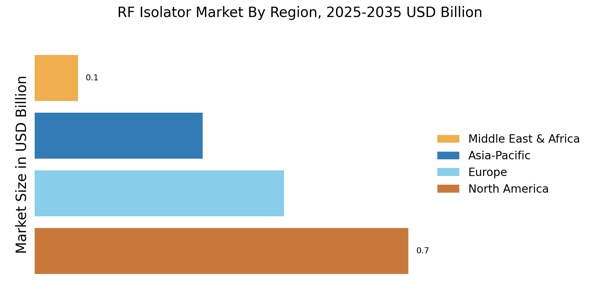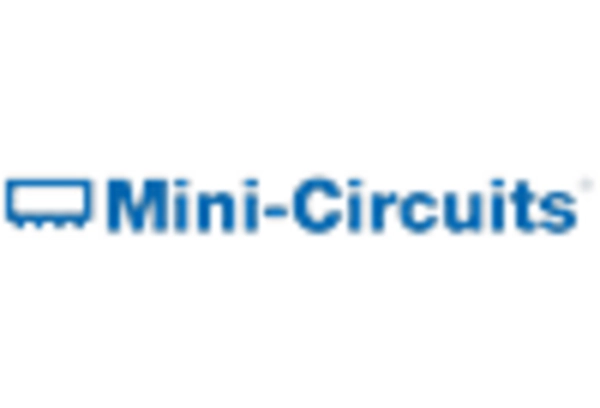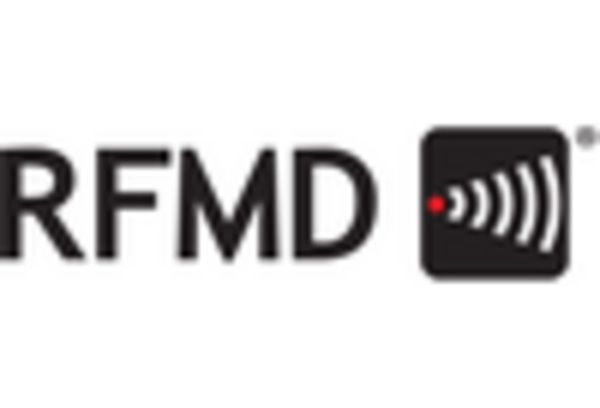Regulatory Compliance and Standards
The RF Isolator Market is increasingly influenced by regulatory compliance and standards that govern performance and safety. As industries such as telecommunications and healthcare become more regulated, the demand for RF isolators that meet these standards is rising. Compliance with international standards ensures that RF isolators function effectively in critical applications, thereby enhancing their marketability. The need for reliable and safe devices is particularly pronounced in sectors where signal integrity is crucial, such as in medical imaging and telecommunications. This regulatory landscape is likely to drive innovation, as manufacturers strive to develop products that not only meet but exceed compliance requirements. Consequently, the RF isolator market may experience growth as companies position themselves to meet these evolving standards, ensuring their products are both competitive and compliant.
Expansion into Emerging Applications
The RF Isolator Market is diversifying as it expands into emerging applications beyond traditional sectors. Industries such as automotive, medical, and consumer electronics are increasingly incorporating RF isolators to enhance device performance. For instance, in the automotive sector, RF isolators are essential for advanced driver-assistance systems (ADAS) and vehicle-to-everything (V2X) communication, which require robust signal integrity. The medical field also benefits from RF isolators in imaging systems and wireless medical devices, where interference can compromise functionality. This diversification is expected to drive market growth, with projections indicating a potential increase in market size by 20% over the next five years. As manufacturers adapt to these new applications, they are likely to innovate and tailor their products to meet specific industry requirements, further solidifying the role of RF isolators in various technological landscapes.
Growing Demand in Telecommunications Sector
The RF Isolator Market is witnessing a notable increase in demand from the telecommunications sector. With the ongoing rollout of 5G networks, the need for efficient RF isolators has become more pronounced. These devices play a critical role in ensuring signal clarity and preventing feedback in high-frequency applications. According to recent estimates, the telecommunications segment accounts for over 40% of the total RF isolator market share, highlighting its significance. As mobile operators expand their infrastructure to accommodate higher data rates and more users, the reliance on RF isolators is expected to grow. This trend is further supported by the increasing adoption of Internet of Things (IoT) devices, which require reliable communication links. Consequently, manufacturers are focusing on developing isolators that can withstand the demands of modern telecommunications systems.
Increased Investment in Research and Development
The RF Isolator Market is benefiting from increased investment in research and development (R&D) by key players. This focus on R&D is aimed at enhancing the performance characteristics of RF isolators, such as improving thermal stability and reducing insertion loss. As competition intensifies, companies are striving to differentiate their products through innovation. The market is projected to see a significant influx of new technologies, including miniaturization and integration with other RF components. This trend is likely to attract more investments, as stakeholders recognize the potential for high returns in a rapidly evolving market. Furthermore, government initiatives supporting technological advancements in communication infrastructure are expected to bolster R&D efforts. As a result, the RF isolator market may witness a transformation in product offerings, catering to the specific needs of various industries.
Technological Advancements in RF Isolator Market
The RF Isolator Market is experiencing a surge in technological advancements that enhance performance and reliability. Innovations in materials and design, such as the use of ferrite and advanced ceramics, are improving isolation levels and power handling capabilities. These advancements are crucial for applications in telecommunications, aerospace, and medical devices, where signal integrity is paramount. The market is projected to grow at a compound annual growth rate (CAGR) of approximately 6% over the next five years, driven by the increasing need for high-performance isolators. Furthermore, the integration of RF isolators in 5G infrastructure is expected to propel demand, as these systems require robust isolation to minimize interference. As a result, manufacturers are investing in research and development to create next-generation RF isolators that meet the evolving needs of various industries.
















Leave a Comment